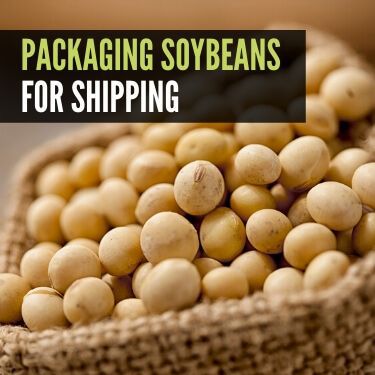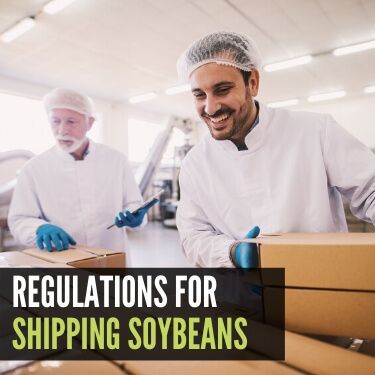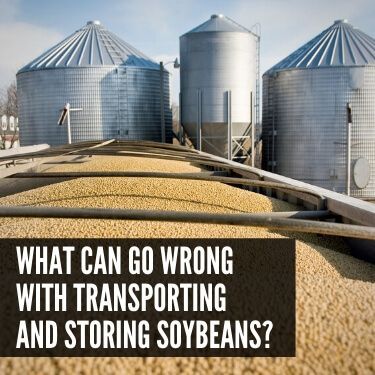If you don’t know much about soybean transportation, then you probably think it would be easy. You just throw the beans in the back of a truck and send them on their way, right? Well actually, no. There’s a lot of planning that goes into soybean transportation, and a lot can go wrong. Soybeans require specific conditions in order to make it to their destination intact and unspoiled. On top of that, if you aren’t careful, you could end up with a truckload of blazing beans!
Soybean transportation is a complex process that involves carefully measuring and maintaining specific temperatures and moisture levels at all times, otherwise, the soybeans could break down and even spontaneously combust! On top of that, you need to follow an extensive list of FDA regulations for the sanitary handling of food products.

In the U.S., soybeans are typically grown in the upper midwest, in states like Iowa, Illinois, and Minnesota. In fact, those three states combined are responsible for producing almost 40% of all soybeans produced in the U.S. However, because of the versatility of the beans, farmers all over the U.S. have been able to grow their own batch of the infamous cash crop.
Despite not being one of the top producers, Pennsylvania has seen a dramatic rise in the popularity of soybeans among farmers. For the past decade, soybean acreage increased 25% year over year, resulting in a staggering rise in the number of soybeans produced in the state. As of 2018, Pennsylvania produces over $200 million worth of soybeans each year. It is the 8th most valuable commodity produced in the state, up from the 11th position in 2004.
No matter where you’re shipping your soybeans from, you still need to follow very specific rules to ensure that your shipment stays fresh. But first, take a look at some of the most common uses for soybeans to get a better idea of why it is such a valuable crop.
Soybeans are a versatile, easy-to-grow crop that has been quickly gaining interest over time. Different companies are finding new ways to use the little unsuspecting bean, and there are now literally thousands of uses for it in a range of different industries.
Soybeans can be used to make:
With that said, it’s no surprise that soybeans are such a valuable crop. However, just because the profits can be substantial does not mean that it is an easy way to make quick money. Let’s dive into the complexities of transporting soybeans by the truckload so you can get your beans on the road!

Soybeans are used everywhere, but because the majority of them are grown in the upper mid-west, they often need to be transported long distances to get where they need to go. Soybeans are often shipped by the truckload, but even then there are two main ways to do that. Depending on several factors, soybeans can be shipped as bulk shipments or in bags.
A bulk shipment is commonly used if the shipment of soybeans is moving to a processing plant to be turned into oil and soybean meal. This works best if the beans are dry, since shipping them in a large container does not allow for adequate ventilation. The ideal moisture content should be below 12% to prevent early spoilage.
However, sometimes when moving to smaller-scale operations, the beans can be shipped in bags or bins. Generally, you can ship soybeans with a higher moisture content if you use the correct packaging methods. You have to make sure you use fabric or woven bags, since those will prevent excess moisture from damaging the beans. Do not use plastic, or the moisture will be trapped inside and the soybeans will spoil.
Bad weather can seriously impact a shipment of soybeans. Soybeans are very sensitive to changes in temperature, and even a little extra moisture could ruin them. If there’s even a chance that it could rain or snow, then extra care should be taken to ensure that the truck is weather-proof and watertight. Additionally, if you are planning on shipping in the summertime, then you should use an insulated or refrigerated truck for shipping instead of a regular freight truck.
So now, you might be wondering how to dry soybeans to less than 12% moisture before shipping. It is incredibly important to get the beans to the correct moisture content to prevent many issues with the shipment, such as a buildup of heat, moisture, or deadly levels of carbon dioxide.
It is very important to dry soybeans as soon as possible after harvest to ensure the highest quality. By planning ahead for the drying phase, soybeans can be harvested earlier on in the season, which reduces the amount of the crop lost to pests, weather, and other conditions. Even though the soybeans will have higher moisture content than if they were harvested later, the proper drying techniques will be able to counteract that without impacting the quality.
There are several different ways to dry soybeans before shipping, but it is most commonly achieved with the use of grain bin fans to circulate dry air around the beans. However, this should be done very carefully, since using air that is too warm or dry could ruin the beans, while air that is too cold or moist won’t be very effective. For optimal results, you will need to measure the humidity of the air, and use the percentage of moisture in the air to determine how much air to circulate around the beans. For example, if the moisture in the air is 18-20%, then you will need to circulate 3 cubic feet of air per minute per bushel (CFM/bu). However, if the air only has 13-15% moisture, then you will only need to circulate 1 CFM/bu.
Other options for drying soybeans before shipping are:

Shipping anything meant for human consumption is automatically going to have some restrictions and regulations associated with it. After all, it is important to maintain food safety standards for public health reasons. When you purchase food, either in a restaurant, in a produce stand, or in the grocery store, you have the expectation that it was handled and stored in conditions that make it safe to eat. The Food and Drug Administration (FDA) is the organization that ensures all food being stored or transported is done so in a sanitary, transparent, and safe way.
The Food Safety Modernization Act (FSMA) was signed into law in 2015 to prevent contamination of the U.S. food supply. The FSMA has several rules, and you should know all of them, but there are a few in particular that you should pay extra attention to. One such rule is about the sanitary transportation of human and animal food.
Here are the requirements that entails:
Working with a trusted carrier or 3PL can take this responsibility completely out of your hands, but there is still something else you will need to know. All facilities intended to produce, package, ship, store, or otherwise handle food for U.S. consumption need to register with the FDA. This includes giving the FDA permission to conduct inspections of the facility at any time to ensure safety and compliance.
Additionally, there is also a rule regarding the growing, handling, and shipping of fresh produce, like soybeans. This rule on produce safety includes several regulations on water quality, types of soil, sprouts, animals present, worker training, worker hygiene, tools, buildings, and equipment. Although there are a lot of rules to follow, don’t let yourself get overwhelmed. It is extremely important to take your time in understanding all the regulations, because you definitely don’t want to get caught being noncompliant.
Soybeans are a perishable commodity, so they will not last forever if they are simply left in storage. Long-term storage of soybeans takes a lot of monitoring and maintenance, but if the proper care is taken, dried soybeans can remain in storage for several years without becoming compromised.
If you aren’t going to transport your soybeans immediately and instead intend to keep them in storage beforehand, then they will need to be dried to less than 8% moisture content. You can follow the same practices for drying the beans as you would for any other purpose, just be sure to monitor the process carefully to avoid over-drying or over-heating.
There are several things you should keep in mind when storing soybeans for a long period of time. Here are some of the best practices you can employ to ensure the greatest success:
If you are able to keep the soybeans at the correct temperature and humidity for the duration of their storage, they will stay good almost indefinitely. However, you should always try to ship beans out for manufacturing as early as reasonably possible to ensure that they are fresh and high-quality.

Soybeans are notorious for their high-fat and high-oil composition. It’s one of the things that makes them such a valuable and versatile commodity. However, those qualities are also the ones that make them volatile, easily damaged, and even dangerous to ship.
When soybeans are left too warm or too moist for even a little bit too long, then they begin the process of breaking down fat. The higher content of water in the soybeans triggers the activation of fat-cleaving enzymes, which produce a significant amount of heat as they break down the fat. This phenomenon of the soybeans self-heating like this is called hydrolytic/enzymatic fat cleavage, and it can have devastating consequences for a batch of soybeans.
Even if this process is caught early and the soybeans are returned to a normal temperature and water content, the process would have left the beans rancid. Soybeans in this condition are no longer suited to be processed into food products, but they may still have applications outside of the food industry, such as in soaps and tires.
If, however, the process of fat cleavage is left to continue, it will only become more intense over time. The high oil and fiber content of the beans could encourage ignition, which would not only ruin the soybeans but could also pose a serious danger to workers and structures.
This process is usually not a problem when truckload shipping soybeans, but the problem can quickly get out of control once it is started. Shipments scheduled to take several days are at greater risk, as well as beans that were not dried properly before being packed for long-term storage. To mitigate the risks even further, you could work with an experienced carrier that will be dedicated to maintaining the proper conditions for the shipment.
If you’re looking for a carrier to handle your soybean transportation needs, look no further than R+L Global Logistics. Our lineup of vetted and reliable carriers have a 99.5% on-time delivery record, and we guarantee that all specifications will be followed to the highest degree of care and professionalism. You can rest easy knowing that your shipment of soybeans would be good hands, and if you have anything else to ship, you know you can count on us. No matter what you need, we’ve got you covered. In addition to truckload shipping, we also offer:
If that sounds good to you, give us a call at (866) 353-7178 for a free freight quote, no strings attached!
R+L Global Logistics
315 NE 14th St., Ocala, FL 34470